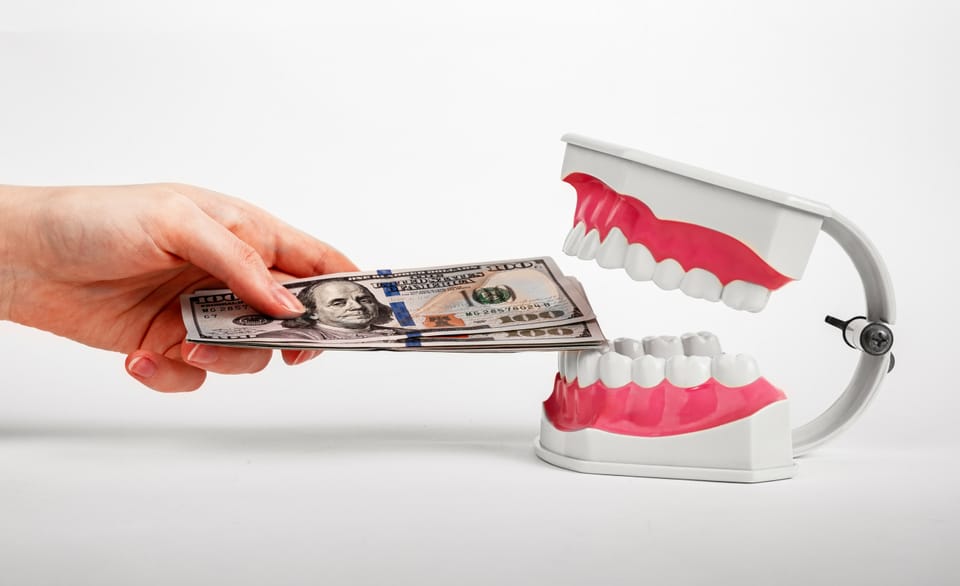Transparent dentistry pricing

Patients lie about flossing. But did you know that a lot them feel guilty about those flossing fibs? Today we look at a new survey of 2,000 adults to better understand how often patients lie to their dentists and why. But first: Dentists report an uptick in stressed-out patients presenting with chipped and cracked teeth.
In today's newsletter:
• How to embrace price transparency in dentistry
• Avoiding back and neck pain as a dentist
• The best dental insurance companies of 2025
• Fostering strong communication with hygienists

'They know we’re here to help them, not sell them'
Most Americans support price transparency in health care. Upfront pricing can make it easier for patients to plan ahead and get the care that they need. But the complexities of the insurance landscape and cash-pay options can make it difficult for dentists to embrace the transparent pricing model.
Vishala Patel, DDS, owner of Edge Dental Designs in McKinney, Tex., uses price transparency at her practice for patients with and without insurance. She's finding that this approach strengthens patient trust and increases treatment planning acceptance rates. Dr. Patel spoke with Dental Bite about the challenges and benefits of adopting price transparency in dentistry. - Carrie Pallardy
Why do you think price transparency is often lacking in dentistry?
Dental practices often lack price transparency due to the high volume of personalized treatment plans that make standardized pricing difficult without first conducting a full exam. Factors such as complexity of procedure, materials used and an individual's specific oral health needs can all have a dramatic effect on costs.
Furthermore, dental insurance policies vary greatly and therefore affect what each patient pays out-of-pocket. Many practices express concern that listing prices without providing context could cause sticker shock among patients, diverting attention away from value and necessity of care and onto costs alone.
Dental care has not seen the same regulatory push for transparency that medical care has, so many practices continue with traditional models such as discussing fees after consultations. But more dentists are beginning to recognize that upfront pricing builds trust with their patients and allows them to make informed decisions.
How did you go about establishing an upfront pricing policy?
Our first step was simplifying our fee structure to ensure it was easy to understand without hidden costs or surprises. Next came clear pricing for common services like cleanings, exams, emergency visits and membership plans as well as training our team to communicate these costs clearly with patients.
One of the greatest challenges was striking a balance between transparency and flexibility. Every patient has different needs, and treatments like complex restorative work almost always vary depending on each case. We had to find an approach that provided accurate estimates while leaving room for adjustments if something unexpected came up during treatment. Our process was completed over approximately two to three months.
How do you approach conversations with patients, with and without insurance, about price?
For patients with insurance, I explain their benefits in simple terms, including what’s covered, what their estimated out-of-pocket costs will be and how we maximize their benefits to reduce their expenses. We also remind them that coverage varies by plan, so we focus on giving them a clear estimate upfront to avoid surprises.
For patients without insurance, I’m upfront about the costs from the start. We offer a transparent fee schedule and walk them through their options, including our membership plan, which helps make preventive care more affordable and includes discounts on other services.
My goal is to make sure every patient feels informed and in control of their decisions, without pressure. Whether they have insurance or not, I emphasize the value of quality care, how it impacts their overall health and work with them to find solutions that fit their budget.

Need more referrals? In an episode of The Thriving Dentist podcast, Gary Takacs and Naren Arulrajah talk some of the best practices to increase referrals in the digital age.
Dental insurance winners. Forbes ranked the best dental insurers of 2025. Anthem and Guardian snagged the top spots.
Kids and cavities. A new national poll conducted by a children's hospital digs into oral health trends in kids. More than a third of parents reported that their kids have tussled with cavities and other dental issues.
Women leaders in dentistry. The Henry M. Goldman School of Dental Medicine (GSDM) chapter of the American Association of Women Dentists (AAWD) snagged two big awards. Aisha Amel M. Daigle, DMD, was named Student Leader of the Year, and the chapter was honored as Student Chapter of the Year.
Ouch. A dentist in Arizona used a pair of non-sterile pliers to remove a patient's implant. The state Board of Dental Examiners voted to revoke his dental license.

The importance of the dentist-hygienist connection
Hygienists are an important part of the dental care team. Conflict and poor communication among members of a care team can have a negative impact on the working environment and patient outcomes. Sally Aube, RDH, explores the role of the dental hygienist and ways that dental practices can implement training initiatives to improve communication between dentists and hygienists.
Why it matters: Fostering strong communication can improve patient outcomes and improve collaboration within a dental practice. It can also help dental hygienists to feel valued in their roles, an important consideration as the dental hygiene shortage persists. (RDH Magazine)
Patients lie through their teeth
Have you ever noticed that a patient's promises of diligent flossing and brushing don't exactly line up with what you're seeing? New research commissioned by Aspen Dental and conducted by Talker Research finds that 57% of patients lie to their dentists about their dental hygiene. While they might not be honest, 48% of patients think that their dentists can figure out the truth during their exams.
Why it matters: Patients might lie to their dentists out of anxiety or embarrassment, which often keeps people from taking care of their oral health. If dentists understand those patient concerns, they can help to alleviate them and encourage regular visits. (Talker Research)
How to beat the neck and back pain of dentistry
Dentistry can result in back and neck discomfort. Gordon Christensen, DDS, PhD, has managed to avoid those musculoskeletal woes over six decades of practice. He shares insight into the ways he has dodged that professional pitfall. Strategies like ergonomic operatory design and new dental loupe designs can help dentists avoid back and neck pain.
Why it matters: Dr. Christensen points out that practices can lose significant revenue if they cancel appointments due to musculoskeletal pain. Implementing strategies to alleviate back and neck issues can be good for dentists' physical and financial health. (Dental Economics)

- New research sheds light on hypophosphatasia and dental issues
- What to expect for dental care if Congress cuts Medicaid funding
- Battle of the brushes: Toothbrushing trends in women and men
- DOMC Live 2025 to bring together dental office managers
- $47M in grants to expand specialty dental clinics in California
Don't be a stranger.
💠 Reply to this email to connect with our team.
💠 Forward Dental Bite to your colleagues.



